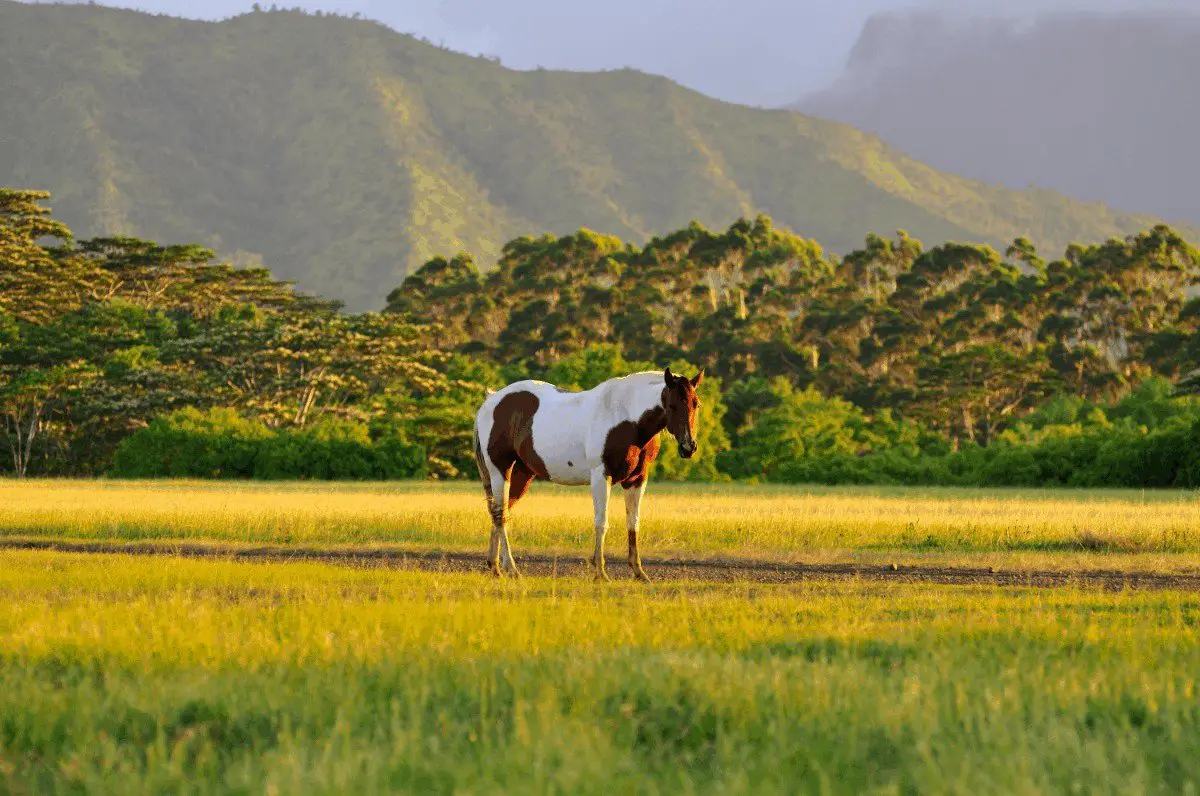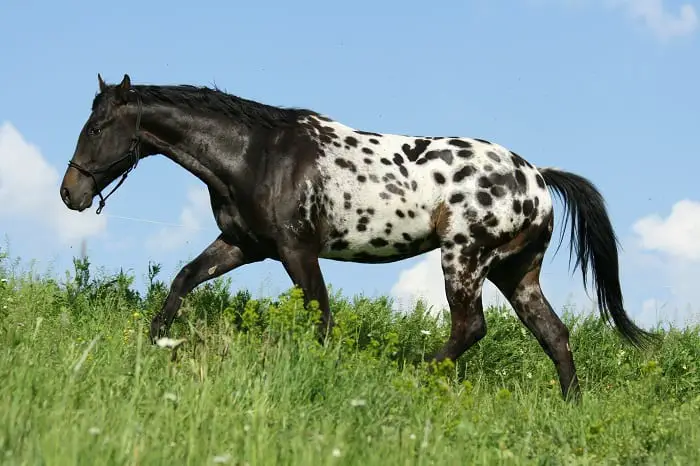Last Updated on December 9, 2021
It is difficult not to be charmed by the unique look of the Appaloosa horse. But, there’s a lot more to Appaloosas than cute spots and speckled noses. The Appaloosa horse origin has a rich history both in North America and Europe.
These horses are most well known for being developed by the Nez Perce Indian tribe during the European colonization of North America. But, they have a history that stretches back even further than that. In this article, I will be discussing the origins of the Appaloosa Horse and their relationship with the Nez Perce Indian tribe.
Appaloosa Horse Origin Before North America
The Appaloosa’s history can be traced back almost as long as human history. A type of spotted horse has been seen in various cave drawings throughout Europe, which dates them back to prehistoric times. These horses may not have been the exact same as the Appaloosa horse that we know today, but they were definitely its ancestors.
Ancient empires such as Greece and Persia also produced artwork and literature detailing spotted horses, which could have been the Appaloosa’s ancestors. Later, the English and the French left records of spotted horses in the 1100s and 1200s.
But, these spotted horses were not brought to North America until the Spanish conquistadors traveled across the ocean in the 1600s. Slowly but surely, the Spaniards brought their horses, including the spotted ones, to North America. Most likely through trade, these horses got into the hands of the Native Americans, and the Appaloosa breed began to make its debut.
What Native American Group Developed the American Appaloosa Horse Origin?
Once the Nez Perce had their hands on a few “spotted horses,” they knew they had found a diamond in the rough. The Nez Perce recognized that these early Appaloosas were intelligent, smooth to ride, and sturdy over uneven surfaces.
So, they began to carefully breed them. As time went on, the Nez Perce gelded or traded horses that they didn’t believe would produce foals with desirable characteristics. The end result were herds of horses, though not all with spots, that the Nez Perce could rely on to swiftly carry them into battle, across great distances, and safely home at the end of the day.
The relationship between the Nez Perce and the Appaloosa was first recorded in the journals of Meriwether Lewis and William Clark (Lewis and Clark) while they were exploring America. They found them in present-day Washington, Oregon, and Idaho. In a journal entry from February 1806, Lewis and Clark said of the Appaloosa, “…some of these horses are pied with large spots of white irregularly scattered and intermixed with black-brown bey or some other dark color.”
The partnership between the Appaloosa and the Nez Perce was a long and beautiful one. But it was all but destroyed in the late 1800s. Slowly but surely, the Nez Perce were being kicked out of their native lands by the Americans. In May of 1877, the native American tribe took a stand against the Americans. Nearly 600 Nez Perce began to fight in what was later called the Nez Perce War.
Appaloosas and the Nez Perce
The Nez Perce resisted but were ultimately defeated and fled to Canada for refuge. The native Americans, their livestock and their horses had to cross great distances over rough terrain. Their Appaloosa horses served them well through this journey, and many made it to safety.
Sadly, the Americans caught up with a group of Nez Perce making the journey while they were resting in present-day Montana while fleeing to Canada. They took over 1,000 of their horses; they sold the horses that they could and shot the rest
The remaining Appaloosas were later forced to breed with draft horses, as the Americans deemed that they were too light-footed to be good for farm work. Very few Appaloosas were seen in the decades following the Nez Perce War. Because of their unique coloring, some of them appeared in circuses and traveling shows. Americans began calling them the Palouse horse, due to the Palouse River where they were first found with the Nez Perce.
Appaloosas Today
Thankfully, in the 1930s, a group of horsemen in Oregon began the process of reviving the Appaloosa breed. Through hard work and dedication, the breed began to grow again and develop new careers and spread into new disciplines.
Today, the Appaloosa has been returned to its former glory. Appaloosa horses can be seen in nearly every state in the USA. Appaloosa breeding has become increasingly popular. There are Appaloosa breed clubs and organizations. Also, there are national meetings to discuss the status of the breed and any progressions that have been made. There are Appaloosa breed shows, where the horses are judged based on their color. Also, they are judged by their resemblance to the original Appaloosa horse.
Appaloosas are also very diverse in riding disciplines. They can be seen in western disciplines such as trail, western pleasure, roping, reining, and barrel racing. Also, they can be seen in English disciplines such as hunger/jumper, three-day eventing, dressage, and even endurance. They make great family pets and kids’ horses, and they are frequently used as lesson horses for people learning how to ride. People today love the Appaloosa for its wit and surefootedness. They are sturdy, easy horses to keep and have captured the hearts of people all around America.
Conclusion
The Appaloosa horse has a rich history in America, thanks to the Nez Perce tribe. The breed would not have developed in America without their careful attention to the horses that they bred. And the measures that they took to preserve them. I hope this article helped you learn about the history of the Appaloosa breed and its relationship with American history. Please share this article and share with us your experiences with Appaloosa horses!
FAQs
What does Appaloosa mean in Native American?
The name "Appalousa" may have originated from the Palouse, a tribe of Native Americans that lived in the Great Plains and Rocky Mountains region and ranged from the Rocky Mountains and Black Hills of what is now North Dakota and South Dakota to the Rocky Mountain states of Utah, Colorado, and New Mexico. The tribe was first mentioned by the Lewis and Clark Expedition in 1804. The Appaloosa horse breed may have been named after these Native American people, but there isn't any evidence to support the theory.
The term "Appaloosa" was first coined by the French explorer Étienne Marchand, who visited the area in 1811 and discovered the Appaloosa horses in the Nez Perce Indian tribe.
The Appaloosa horse breed is now recognized as one of the oldest breeds in North America, pre-dating the now more common breeds such as the Quarter Horse. The breed was originally developed by the Nez Perce people of Idaho and Oregon as a general-purpose horse for hunting and war.
What is the temperament of an Appaloosa horse?
The Appaloosa horses are known for being patient, respectful, and will not challenge their human handlers. They are tolerant, and will try to understand what the handler wants from them. Sometimes, though, they can be stubborn, so they need someone who can provide them with direction.
Appaloosas are very popular as riding horses because they are well-balanced and nimble. They can be easily trained due to their intelligence and willingness to please their owners. They are easy going and will even get along with other animals in the household. Because of their gentle temperament they make great mounts for children and children just love spending time with Appaloosas.
What is a snowflake Appaloosa?
Snowflake Appaloosa (also known as "Flecks") are a type of Appaloosa horse with white spots, flecks, or splotches which are distributed in random patterns all over the body. The Appaloosa's spots are the result of a combination of genetics, white hair, and skin pigment that causes white hair to develop in certain areas.
This pattern is different from the traditional leopard pattern which is found in regular Appaloosa horses. It usually appears when an individual has one or more white parents and then inherits genes that produce this variation. It is thought that these flecks may be caused by a mutation or by an intensification in the pigment gene with age.
Do all Appaloosa horses have spots?
Appaloosa horses are known to have distinctive white patterns on their body. This is not always the case with all Appaloosa horses. Some of them have spots, others have stripes and some are mottled. Depending on the type, some might also have multiple colors on their bodies.
Some Appaloosa horses are more likely to be born with these markings than others, but it is also possible for an Appaloosa horse to be born without any markings at all. This variation in markings could be due to the different breeds of horses combined in the same line or it could be due to the mutation of the gene that determines color.
Michael Dehaan is a passionate horse owner, horse rider, and lover of all things equine. He has been around horses since he was a child, and has grown to become an expert in the field. He has owned and ridden a variety of horses of different breeds, and has trained many to compete in shows and competitions. He is an experienced horseman, having worked with and competed many horses, including his own. He is an active member of the equestrian community, participating in events and teaching riding lessons.


